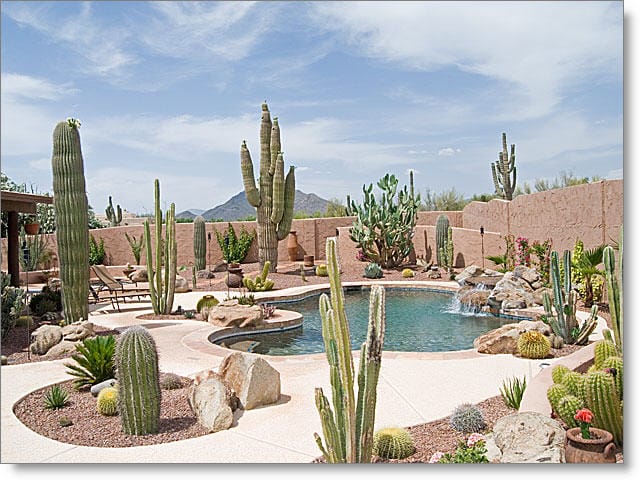Desert Landscaping: Design a Stunning Low-Water Landscape
By Innovation Grounds
Creating a beautiful desert landscape that thrives with minimal water is not only an environmentally conscious decision but also an opportunity to design a stunning outdoor space. Whether you’re looking to conserve water or embrace the natural beauty of the desert, desert landscaping is the perfect solution. In this blog post, we’ll explore the basics of desert landscaping and provide tips for designing a low-water landscape that is both functional and aesthetically pleasing.
What is Desert Landscaping?
Desert landscaping, also known as xeriscaping, involves designing outdoor spaces using drought-tolerant plants, efficient irrigation systems, and materials that minimize water usage. This style of landscaping is especially popular in arid regions, where water conservation is a priority. However, anyone can incorporate desert landscaping principles to create a stunning yard with minimal environmental impact.

Why Choose Desert Landscaping?
Water Conservation: One of the main benefits of desert landscaping is its focus on water conservation. By using drought-resistant plants and reducing the overall water demand of your landscape, you can significantly lower your water bill while doing your part to protect the environment.
Low Maintenance: Desert landscapes require less upkeep than traditional lawns. With the right plant selection and design, you’ll spend less time watering, mowing, and dealing with pests.
Aesthetic Appeal: A well-designed desert landscape can be strikingly beautiful, incorporating bold colors, textures, and forms that reflect the natural beauty of the desert. Cacti, succulents, and native grasses create a visually intriguing environment that evolves throughout the year.

Tips for Designing a Stunning Low-Water Desert Landscape
1. Choose the Right Plants
When it comes to desert landscaping, plant selection is key. Opt for native or drought-tolerant plants that thrive in arid conditions and require minimal water. Some excellent choices include:
- Cacti: From the iconic saguaro to the smaller barrel cactus, cacti come in various shapes and sizes, adding both structure and visual interest to your landscape.
- Succulents: Plants like agave, aloe vera, and yucca are known for their ability to store water in their leaves, making them perfect for desert environments.
- Desert Wildflowers: Many desert wildflowers, such as poppies and primroses, can survive with minimal watering and bring vibrant colors to your garden.
- Native Grasses: Grasses such as blue grama or red fountain grass provide texture and movement while requiring little water.
2. Group Plants by Water Needs
To further minimize water usage, group plants with similar water requirements together. This practice ensures that you’re watering only the areas that need it, reducing waste and improving water efficiency. Plants that thrive in dry conditions should be kept separate from those that need a little more moisture.
3. Use Efficient Irrigation Systems
In a desert landscape, efficient watering is crucial. Consider installing a drip irrigation system, which delivers water directly to the base of each plant, minimizing evaporation and runoff. A smart irrigation controller can also help monitor weather conditions and adjust watering schedules accordingly.
4. Incorporate Hardscape Elements
Desert landscaping isn’t just about plants; hardscape elements like rocks, gravel, and decorative stone can enhance the beauty of your outdoor space while reducing the need for water. Use rocks to create focal points, pathways, or raised garden beds. Gravel is an excellent choice for creating textured ground covers that retain moisture while preventing soil erosion.
5. Use Mulch to Retain Moisture
A thick layer of mulch around your plants helps retain moisture in the soil, reduces evaporation, and keeps the roots cool during the hot summer months. Organic mulches like shredded bark or compost can also improve soil health over time.
6. Opt for Low-Water Lawn Alternatives
Traditional lawns are notoriously water-hungry, but you can still achieve a lush, green look with alternative groundcovers. Consider using buffalo grass, a drought-tolerant alternative that requires less water and maintenance than typical turf grass.
7. Consider Seasonal Color
One of the perks of desert landscaping is the ability to design a landscape that offers year-round beauty. Many desert plants, such as desert marigolds and red yuccas, bloom at different times of the year, providing pops of color throughout the seasons.

Conclusion
Desert landscaping is a sustainable and stunning way to transform your outdoor space while conserving water. By selecting the right plants, incorporating efficient irrigation, and using hardscape elements, you can create a beautiful, low-water landscape that thrives in dry conditions. Whether you live in a desert region or simply want to incorporate the beauty of the desert into your yard, desert landscaping is a fantastic way to achieve a striking and eco-friendly garden.
With these tips in mind, you’re ready to start designing your own desert oasis. Embrace the natural beauty of the desert and enjoy a landscape that’s both beautiful and easy to maintain!



